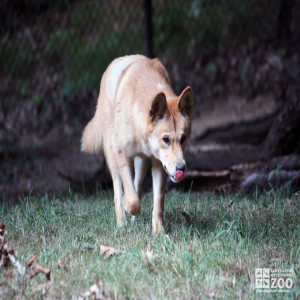Dingo
[Canis lupus dingo]

The dingo has a head and body length of approximately 46 to 49 inches, and its tail length is 11 to 13 inches. Their shoulder height is about 20 inches with a weight of 22 to 44 pounds. They are usually tawny yellow in color, but some individuals are white, black, brown, rust, or other shades. The feet and the tip of the tail are often white. The dingo can be distinguished from other forms of canines by its longer muzzle, more massive molariform teeth, and longer, more slender canine teeth.
The oldest definitely known fossils of the dingo date from about 3,500 years ago, but other remains may be as old as 8,600 years. Humans arrived in Australia at least 30,000 years ago. The dingo evidently was brought in long afterward, but before true domestication had been achieved, and it was able to establish wild populations. There are also wild dog populations in New Guinea and Timor which are related to the dingo group. Median life expectancy is 10 years.
Location: Kookaburra Station
Share:
Range
The Dingo's range is Australia.
Habitat
Dingoes inhabit the arid hot deserts, tropical wetlands, and the alpine-like moorlands of Australia. They have a preference for woodland and grassland areas.
Conservation Status
VulnerablePrimary Threats
Human Wildlife CoexistenceGestation
The gestation period for the dingo is about 63 days.
Litter
Dingoes may have one to eight pups but usually four to five.
Behavior
Dingos are mostly nocturnal. Daily movements average about 10 to 20 km. On the average, individuals are active for 15.25 hours and at rest for 8.75 hours each day. The dingo is basically solitary, but individuals in a given area form a loose, amicable association and sometimes come together. Fighting may develop among members of different groups. Although not particularly vocal, the dingo has a variety of sounds. Howls, probably meant to locate others from its group and repel intruders, are frequently heard during the annual breeding season. Dingoes have clearly defined territories, except when hunting. Although regularly captured and tamed by natives and other people of Australia, the dingo has never been successfully domesticated.
Reproduction
In the wild, dingo pups are born in late winter and spring. Yearlings may assist an older pair to raise their pups. Independence is generally achieved by 3 to 4 months, but the young animals often then associate with a mature male
Wild Diet
Mostly small mammals; occasional kangaroos, cattle or sheep
